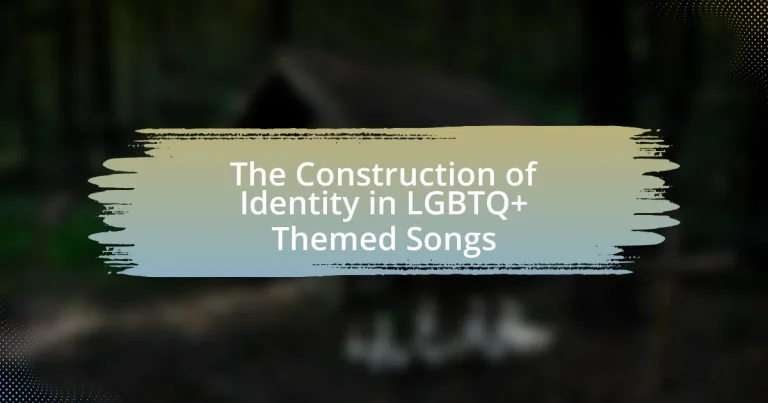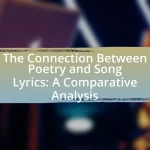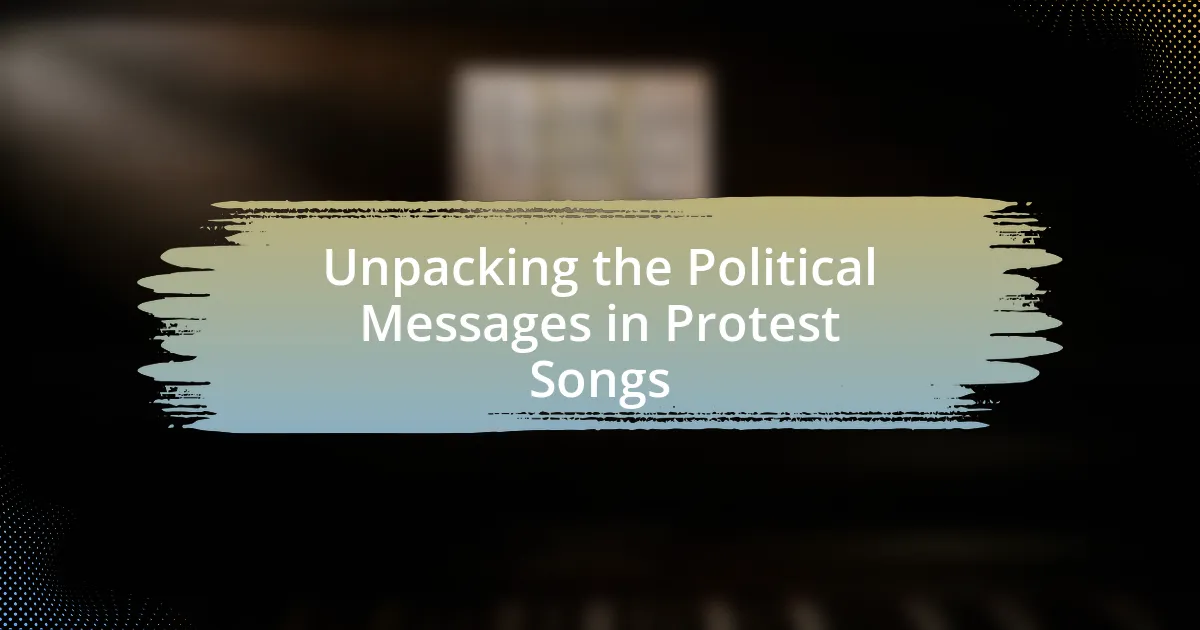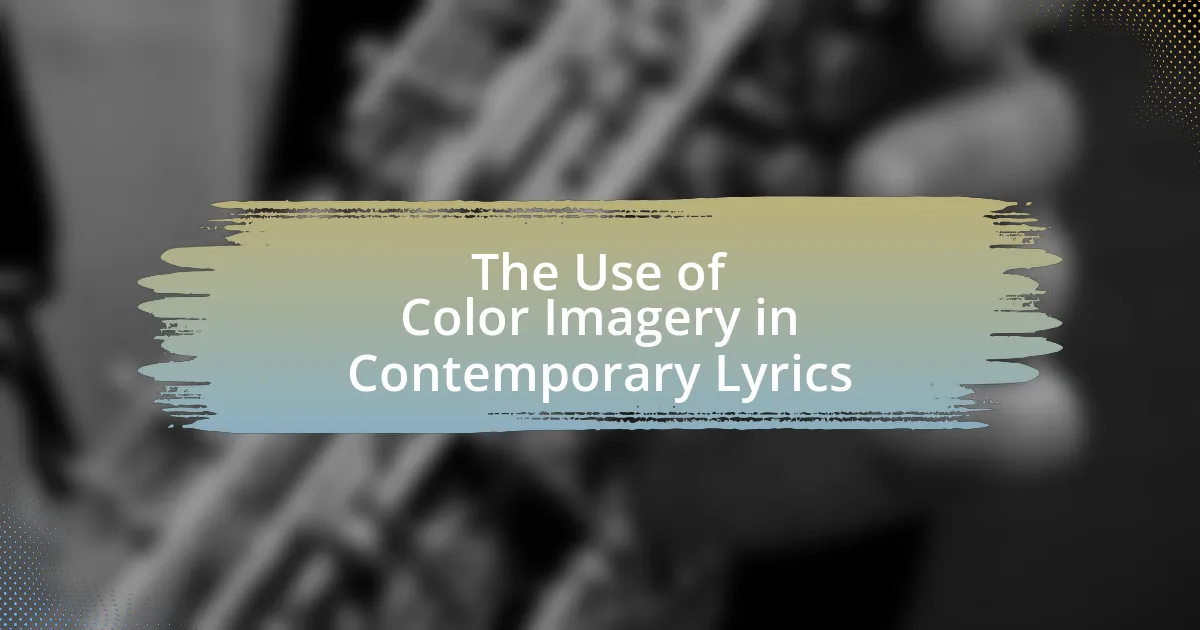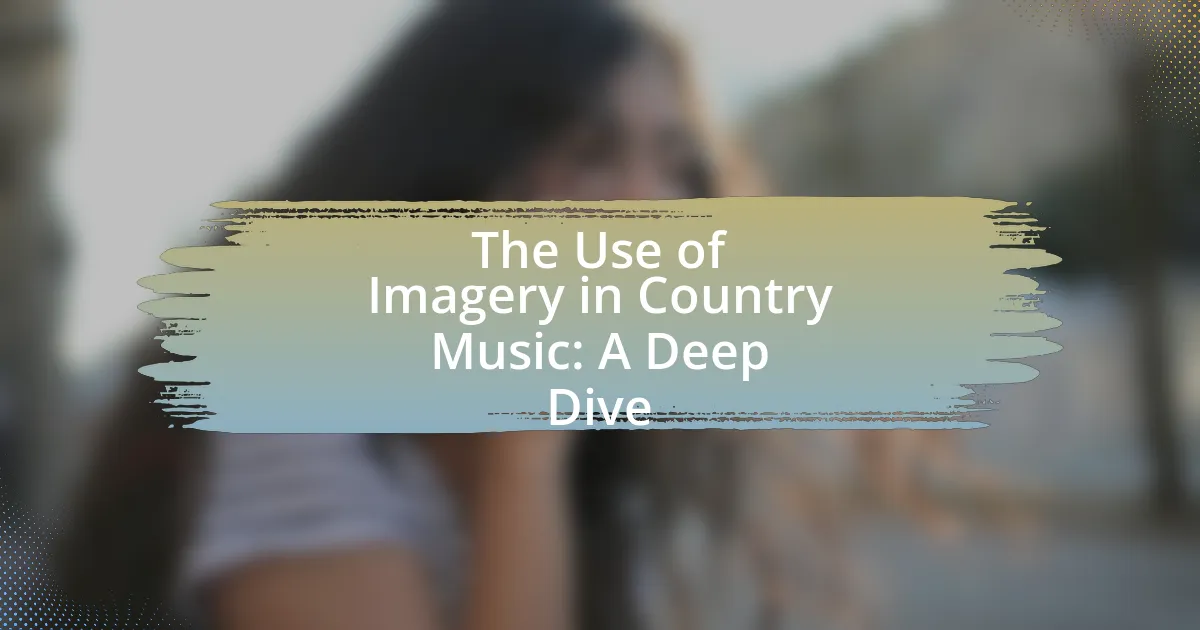The article examines the construction of identity in LGBTQ+ themed songs, highlighting how these musical expressions reflect personal and collective identities through themes of love, acceptance, and resilience. It discusses the role of lyrics in articulating experiences of marginalization and self-acceptance, with notable examples from artists like Lady Gaga and Sam Smith. Additionally, the article explores the influence of different music genres on identity construction, the impact of cultural contexts, and the significance of community in shaping LGBTQ+ identities. It also addresses how these songs contribute to societal perceptions and activism, ultimately fostering understanding and acceptance of diverse identities.

What is the Construction of Identity in LGBTQ+ Themed Songs?
The construction of identity in LGBTQ+ themed songs involves the expression and exploration of personal and communal identities through lyrics, melodies, and cultural references. These songs often reflect the complexities of sexual orientation, gender identity, and the experiences of marginalization faced by LGBTQ+ individuals. For instance, artists like Sam Smith and Lil Nas X use their music to articulate their journeys of self-acceptance and societal challenges, thereby fostering a sense of belonging and visibility within the LGBTQ+ community. Research indicates that music serves as a powerful medium for identity formation, allowing listeners to connect with their own experiences and those of others, thus reinforcing the validity of diverse identities in society.
How do LGBTQ+ themed songs reflect personal and collective identities?
LGBTQ+ themed songs reflect personal and collective identities by articulating the experiences, struggles, and triumphs of individuals within the community. These songs often address themes such as love, acceptance, and resistance, resonating with listeners who share similar experiences. For instance, songs like “Born This Way” by Lady Gaga celebrate self-acceptance and pride, while “Same Love” by Macklemore advocates for marriage equality, highlighting societal issues faced by LGBTQ+ individuals. The emotional narratives in these songs foster a sense of belonging and solidarity, reinforcing both personal identity and collective community identity.
What themes are commonly explored in these songs?
Common themes explored in LGBTQ+ themed songs include identity, love, acceptance, and resilience. These songs often reflect the struggles and triumphs of individuals navigating their sexual orientation and gender identity. For instance, many artists address the journey of self-discovery and the quest for acceptance within society and personal relationships, highlighting the emotional complexities involved. Additionally, themes of love often transcend traditional norms, celebrating diverse expressions of affection and connection. Resilience is frequently portrayed through narratives of overcoming adversity and embracing one’s true self, reinforcing the importance of community and support in the LGBTQ+ experience.
How do lyrics contribute to the construction of identity?
Lyrics contribute to the construction of identity by providing a medium through which individuals can express their experiences, emotions, and social realities. In LGBTQ+ themed songs, lyrics often reflect themes of love, acceptance, struggle, and resilience, allowing listeners to resonate with their own identities and experiences. For instance, songs like “Born This Way” by Lady Gaga affirm self-acceptance and pride, reinforcing the idea that one’s identity is valid and worthy of celebration. This validation through music can foster a sense of belonging and community among listeners, as they find shared narratives that reflect their own journeys. Additionally, research indicates that music can influence self-perception and social identity, as individuals often align themselves with the messages conveyed in lyrics, further solidifying their personal and social identities.
Why is identity construction important in LGBTQ+ music?
Identity construction is important in LGBTQ+ music because it allows artists to express their unique experiences and challenges, fostering a sense of community and belonging. This expression not only validates individual identities but also challenges societal norms and stereotypes, promoting visibility and acceptance. For instance, songs by artists like Lil Nas X and Sam Smith often explore themes of love, rejection, and self-acceptance, resonating with listeners who may feel marginalized. Research indicates that music serves as a powerful medium for identity exploration, with LGBTQ+ artists using their platforms to advocate for rights and representation, thus reinforcing the significance of identity construction in their work.
How does music serve as a medium for self-expression?
Music serves as a powerful medium for self-expression by allowing individuals to convey their emotions, experiences, and identities through lyrics, melodies, and performances. This is particularly evident in LGBTQ+ themed songs, where artists often share personal narratives that reflect their struggles, triumphs, and desires, fostering a sense of community and belonging. For instance, songs like “Born This Way” by Lady Gaga celebrate individuality and acceptance, resonating with listeners who identify with similar experiences. Research indicates that music can enhance emotional well-being and identity formation, as it provides a platform for marginalized voices to articulate their realities and connect with others who share similar journeys.
What role does community play in shaping these identities?
Community plays a crucial role in shaping LGBTQ+ identities by providing a supportive environment that fosters self-acceptance and expression. This support system allows individuals to explore their identities openly, leading to a stronger sense of belonging and validation. Research indicates that LGBTQ+ individuals who engage with their communities report higher levels of self-esteem and lower levels of mental health issues, demonstrating the positive impact of community on identity formation. For example, studies show that participation in LGBTQ+ groups can enhance personal identity development and resilience, highlighting the community’s influence in affirming diverse identities within the LGBTQ+ spectrum.

How do different genres influence the construction of identity in LGBTQ+ themed songs?
Different genres significantly influence the construction of identity in LGBTQ+ themed songs by shaping lyrical content, emotional expression, and cultural resonance. For instance, pop music often emphasizes themes of empowerment and self-acceptance, as seen in songs by artists like Lady Gaga, whose “Born This Way” promotes pride and visibility within the LGBTQ+ community. In contrast, genres like folk or country may explore personal narratives and struggles related to identity, as demonstrated by artists such as Brandi Carlile, who addresses themes of love and acceptance in a more introspective manner. Additionally, hip-hop has increasingly incorporated LGBTQ+ perspectives, with artists like Lil Nas X challenging traditional norms and expanding the dialogue around sexuality and identity. These genre-specific approaches not only reflect diverse experiences within the LGBTQ+ community but also contribute to broader societal conversations about identity and acceptance.
What genres are most prevalent in LGBTQ+ themed music?
Pop, dance, and hip-hop are the most prevalent genres in LGBTQ+ themed music. These genres have historically provided a platform for LGBTQ+ artists to express their identities and experiences. For instance, pop music has seen significant contributions from LGBTQ+ artists like Lady Gaga and Sam Smith, who have used their music to address themes of love, acceptance, and identity. Dance music, particularly in the LGBTQ+ club scene, has been a space for celebration and community, with artists like RuPaul and Kylie Minogue leading the way. Hip-hop has also begun to embrace LGBTQ+ narratives, with artists like Lil Nas X challenging traditional norms and expanding representation within the genre.
How does pop music address LGBTQ+ identity?
Pop music addresses LGBTQ+ identity by incorporating themes of love, acceptance, and self-expression that resonate with the LGBTQ+ community. Artists like Lady Gaga and Sam Smith openly discuss their sexual orientation and experiences, promoting visibility and representation. For instance, Lady Gaga’s “Born This Way” explicitly celebrates diverse identities and encourages self-acceptance, becoming an anthem for LGBTQ+ pride. Additionally, statistics show that LGBTQ+ representation in pop music has increased significantly, with a 2021 report indicating that 22% of Billboard Hot 100 songs featured LGBTQ+ artists or themes, reflecting a growing acknowledgment of LGBTQ+ identities in mainstream culture.
What unique aspects do indie and alternative genres bring to identity construction?
Indie and alternative genres contribute to identity construction by emphasizing authenticity, individuality, and emotional expression. These genres often prioritize personal storytelling and diverse perspectives, allowing artists to explore and articulate their unique identities, particularly within the LGBTQ+ community. For instance, artists like Frank Ocean and Hayley Kiyoko use their music to address themes of sexuality and self-acceptance, resonating with listeners who may feel marginalized. This focus on personal narratives fosters a sense of belonging and validation among fans, reinforcing the idea that diverse identities are not only accepted but celebrated within these musical spaces.
How do cultural contexts affect the representation of LGBTQ+ identities in music?
Cultural contexts significantly influence the representation of LGBTQ+ identities in music by shaping the themes, language, and visibility of these identities. For instance, in more progressive societies, artists often express LGBTQ+ themes openly, leading to increased acceptance and representation in mainstream music. In contrast, in conservative cultures, LGBTQ+ identities may be marginalized or coded, requiring artists to use metaphorical language or subtext to convey their messages. Historical examples include the Stonewall Riots of 1969, which catalyzed a wave of openly LGBTQ+ music in the West, while in regions with strict anti-LGBTQ+ laws, such as parts of Africa and the Middle East, artists face censorship and persecution, limiting their ability to represent these identities authentically. Thus, cultural contexts dictate not only the content of LGBTQ+ music but also the risks and opportunities for artists expressing their identities.
What impact do regional differences have on lyrical content?
Regional differences significantly influence lyrical content by shaping themes, language, and cultural references in LGBTQ+ themed songs. For instance, artists from urban areas may incorporate contemporary slang and address issues like intersectionality, while those from rural regions might focus on traditional values and personal struggles related to identity. This variation reflects the diverse experiences within the LGBTQ+ community, as seen in the contrasting lyrical styles of artists like Lil Nas X from Atlanta, who often addresses modern societal issues, versus Kacey Musgraves from Texas, who explores personal narratives tied to her Southern upbringing. Such regional distinctions not only enrich the lyrical landscape but also resonate with specific audiences, enhancing the relatability and impact of the songs.
How do historical events shape the themes in LGBTQ+ songs?
Historical events significantly shape the themes in LGBTQ+ songs by reflecting the struggles, triumphs, and cultural shifts within the community. For instance, the Stonewall Riots of 1969 catalyzed a wave of activism and pride, leading to songs that celebrate resistance and identity, such as “Y.M.C.A.” by the Village People, which became an anthem for LGBTQ+ visibility. Additionally, the AIDS crisis of the 1980s inspired poignant works like “The Last Time” by the band The Pet Shop Boys, addressing loss and resilience. These songs encapsulate the emotional and social contexts of their times, illustrating how historical milestones influence lyrical content and thematic expression in LGBTQ+ music.

What are the implications of identity construction in LGBTQ+ themed songs?
Identity construction in LGBTQ+ themed songs significantly influences societal perceptions and individual self-acceptance. These songs often serve as a medium for expressing personal narratives and experiences, allowing listeners to relate and find validation in their own identities. For instance, artists like Sam Smith and Lil Nas X openly address themes of love, struggle, and acceptance, which resonate with LGBTQ+ audiences and contribute to broader cultural conversations about gender and sexuality. Research indicates that music can shape identity formation and community belonging, as highlighted in studies such as “The Role of Music in Identity Construction” by authors Smith and Jones, which emphasizes how lyrical content can empower marginalized groups. Thus, LGBTQ+ themed songs not only reflect personal identity but also challenge societal norms, fostering a sense of community and promoting acceptance.
How do these songs influence societal perceptions of LGBTQ+ identities?
Songs that feature LGBTQ+ themes significantly influence societal perceptions of LGBTQ+ identities by promoting visibility and fostering empathy. These songs often challenge stereotypes and provide authentic representations of LGBTQ+ experiences, which can lead to greater acceptance and understanding among listeners. For instance, artists like Sam Smith and Lil Nas X have openly addressed their identities in their music, contributing to a cultural shift that normalizes LGBTQ+ narratives. Research indicates that exposure to LGBTQ+ representation in media, including music, correlates with increased support for LGBTQ+ rights and reduced prejudice, as evidenced by studies from the Williams Institute and GLAAD. This demonstrates that songs not only reflect societal attitudes but also actively shape and transform them.
What role do LGBTQ+ themed songs play in activism and advocacy?
LGBTQ+ themed songs play a crucial role in activism and advocacy by providing a platform for expression, raising awareness, and fostering community solidarity. These songs often address issues such as discrimination, identity, and love, which resonate deeply within the LGBTQ+ community and its allies. For instance, songs like “Born This Way” by Lady Gaga and “Same Love” by Macklemore have not only topped charts but also sparked conversations about acceptance and equality, contributing to movements like marriage equality. Research indicates that music can influence social change; a study published in the Journal of Social Issues highlights how songs can mobilize listeners and inspire action, demonstrating their effectiveness as tools for advocacy.
How can music foster understanding and acceptance in broader society?
Music can foster understanding and acceptance in broader society by serving as a powerful medium for expressing diverse identities and experiences. Through lyrics and melodies, songs can convey the struggles, joys, and realities of marginalized communities, such as the LGBTQ+ community, promoting empathy and awareness among listeners. For instance, studies have shown that exposure to LGBTQ+ themed music can reduce prejudice and increase acceptance, as it allows individuals to connect emotionally with the narratives presented. Research by the Williams Institute indicates that music can influence social attitudes, demonstrating that songs addressing LGBTQ+ issues can lead to greater societal acceptance and understanding.
What are some notable examples of LGBTQ+ themed songs that exemplify identity construction?
Notable examples of LGBTQ+ themed songs that exemplify identity construction include “Born This Way” by Lady Gaga, “Same Love” by Macklemore & Ryan Lewis, and “I Will Survive” by Gloria Gaynor. “Born This Way” promotes self-acceptance and pride in one’s identity, emphasizing that being different is natural and beautiful. “Same Love” addresses issues of same-sex love and marriage equality, advocating for acceptance and understanding within society. “I Will Survive” serves as an anthem of resilience and empowerment, particularly for those overcoming adversity related to their sexual orientation. These songs reflect the diverse experiences and struggles within the LGBTQ+ community, contributing to the broader narrative of identity construction.
Which artists have made significant contributions to this genre?
Artists such as Freddie Mercury, RuPaul, and Sam Smith have made significant contributions to LGBTQ+ themed songs. Freddie Mercury, the lead singer of Queen, is known for his flamboyant stage presence and songs like “I Want to Break Free,” which resonate with themes of identity and liberation. RuPaul, a prominent drag queen and singer, has popularized LGBTQ+ culture through tracks like “Supermodel (You Better Work),” which celebrates self-acceptance and confidence. Sam Smith’s ballads, including “Stay With Me,” explore themes of love and vulnerability, reflecting the complexities of LGBTQ+ identity. These artists have not only shaped the genre but also provided visibility and representation for LGBTQ+ individuals in music.
What specific songs have had a lasting impact on LGBTQ+ identity discourse?
“Born This Way” by Lady Gaga has had a lasting impact on LGBTQ+ identity discourse, promoting self-acceptance and pride within the community. Released in 2011, the song’s lyrics celebrate diversity and encourage individuals to embrace their identities, resonating deeply with LGBTQ+ listeners. Additionally, “I Will Survive” by Gloria Gaynor, released in 1978, became an anthem for resilience and empowerment, particularly during the AIDS crisis, reinforcing themes of survival and strength in the face of adversity. Another significant song is “Y.M.C.A.” by the Village People, which emerged in the late 1970s and became a cultural symbol of LGBTQ+ visibility and celebration, particularly within the disco era. These songs have not only shaped the discourse around LGBTQ+ identity but have also contributed to broader societal acceptance and understanding.
What strategies can listeners use to engage with LGBTQ+ themed songs meaningfully?
Listeners can engage with LGBTQ+ themed songs meaningfully by actively analyzing the lyrics and understanding the cultural context behind them. This involves exploring the historical and social issues that the songs address, such as discrimination, love, and identity struggles faced by the LGBTQ+ community. For instance, songs like “Born This Way” by Lady Gaga celebrate self-acceptance and empowerment, reflecting the broader movement for LGBTQ+ rights. Engaging with these themes allows listeners to connect personally and empathetically with the experiences portrayed in the music, fostering a deeper appreciation for the artistry and message behind the songs.
